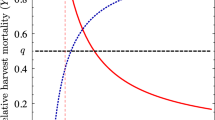Summary
Stability of the stock-harvesting system regulated by a feedback control procedure of catch quota is examined. In the procedure considered, catch quota is changed proportionally to the difference between current and the target stock level (with a proportionality constanth) and to the annual stock growth rate (with a proportionality constantg). Condition for the local stability of the target equilibrium is obtained as a function of the stock-recruitment relation, survival probability of adults, target stock level, time lag before implementation of regulation, age of sexual maturity of the stock, and proportionality constantsg andh. It is shown that, (1) the procedure has the stabilizing effect; it can stabilize the target stock level that is unstable under constant harvest, (2) lower target stock level favors largerg and smallerh, when the target is set around MSYL (the stock level that gives MSY), (3) the degree of stability, measured by the time required to recover the target stock level, is an increasing function of the target stock level, (4) stability and sustainable yield are in trade-off, (5) time delay caused by the time needed before sexual maturity does not affect the stability significantly, but the effect of the time lag before implementation of regulation is significant. Comparison between harvest-control and effort-control procedures is also made, and the advantage of the latter in terms of stability is shown.
Similar content being viewed by others
References
Bergh, M. O. and W. M. Getz (1988) Stability of discrete age-structured and aggregated delay-differential population models.J. Math. Biol. 26: 551–558.
Clark, C. W. (1975) A delayed-recruitment model of population dynamics with an application to baleen whale populations.J. Math. Biol. 3: 381–391.
De Angelis, D. L. (1980) Energy flow, nutrient cycling and ecosystem resilience.Ecology 61: 764–771.
Fisher, M. E. and B. S. Goh (1984) Stability results for delayed-recruitment models in population dynamics.J. Math. Biol. 19: 147–156.
Getz, W. M. (1980) The ultimate sustainable yield problem in nonlinear age-structured populations.Math Biosci. 48: 272–292.
Getz, W. M. and R. G. Haight (1989)Population Harvesting: Demographic Models of Fish, Forest, and Animal Resources. Princeton University Press, Princeton.
Goh, B. S. (1977) Stability in a stock-recruitment model of an exploited fishery.Math. Biosci. 33: 359–372.
Levin, S. A. and C. P. Goodyear (1980) Analysis of an age-structured fishery model.J. Math. Biol. 9: 245–274.
Levin, S. A. and R. M. May (1976) A note on difference-delay equations.Theor. Popul. Biol. 9: 178–187.
May, R. M. (1974)Stability and Complexity in Model Ecosystems. 2nd. ed. Princeton University Press, Princeton.
Murray, J. D. (1989)Mathematical Biology. Springer-Verlag, Berlin-Heidelberg-New York.
Pimm, S. L. (1984) The complexity and stability of ecosystem.Nature,307: 321–326.
Reed, W. J. (1980) Optimum age-specific harvesting in a nonlinear population models.Biometrics 36: 579–593.
Sakuramoto, K. and S. Tanaka (1989) A simulation study on management of whale stocks considering feedback systems.Rep. int. Whal. Commn. special issue II: 199–210.
Tanaka, S. (1980) A theoretical consideration on the management of a stock-fishery system by catch quota and on its dynamic properties.Nippon Suisan Gakkaishi 46: 1477–1482.
Author information
Authors and Affiliations
Additional information
An erratum to this article is available at http://dx.doi.org/10.1007/BF02514793.
Rights and permissions
About this article
Cite this article
Harada, Y., Sakuramoto, K. & Tanaka, S. On the stability of the stock-harvesting system controlled by a feedback management procedure. Res Popul Ecol 34, 185–201 (1992). https://doi.org/10.1007/BF02513530
Issue Date:
DOI: https://doi.org/10.1007/BF02513530




